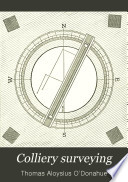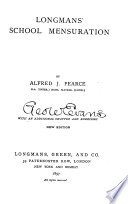 | Thomas Aloysius O'Donahue - Mine surveying - 1896 - 186 pages
...multiply the base by half the perpendicular. PROB. VII. To find the area of a trapezoid. Multiply half of the sum of the two parallel sides by the perpendicular distance between them, and the product will be the area. Let ABCD (Fig. 61) be a trapezoid. The side EC = 40, Fio. 61. Pra. 62.... | |
 | Alfred John Pearce - 1897 - 202 pages
...of which is 1 yd. 10. June, 1890.— Prove that the area of a trapezoid is one-half the. product of the sum of the two parallel sides by the perpendicular distance between them. The area of a trapezoidal field is 4J ac. ; the perpendicular distance between the parallel sides is... | |
 | Floyd Davis - Mining engineering - 1900 - 148 pages
...is the area of a trapezoid determined? A. The area of a trapezoid is found by multiplying one-half the sum of the two parallel sides by the perpendicular distance between them. Q. 87. What is the area of a trapezoid whose two parallel sides are 12 and 16 feet respectively, and... | |
 | Nehemiah Hawkins - Steam engineering - 1901 - 354 pages
...a Trapezoid. NOTE. A Trapezoid is a trapezium having two of its sides parallel. RULE. Multiply half the sum of the two parallel sides by the perpendicular distance between them. k Fig. 38. Let the figure be the trapezoid, the sides 7 and 5 being parallel; and 3 the perpendicular... | |
 | William Kent - Engineering - 1907 - 1206 pages
...sum of tile perpendiculars let fall on it from opposite angles. Area of a trapezold = product of half the sum of the two parallel sides by the perpendicular distance between them. To find the area of any quadrilateral figure.— Divide the quadrilateral into two triangles; the sum... | |
 | Nehemiah Hawkins - Machine-shop practice - 1903 - 362 pages
...OF A TRAPEZOID. A Trapezoid is a trapezium having two of its sides parallel. RULE. — Multiply half the sum of the two parallel sides by the perpendicular distance between them. 62 USEFUL MEASUREMENTS. Let the figure be the trapezoid, the sides 7 and 5 being parallel ; and 3 the... | |
 | Frederick Thomas Hodgson - Architecture, Domestic - 1904 - 370 pages
...perpendiculars, de and lif 18 and 16 feet? HX 8=336 i =714 sq.ft. Ans. Problem IV. — To find the area of a trapezoid. Rule. — Multiply the sum of...between them, and half the product will be the area. Example i. — Required the area of the trapezoid, abed, having given ab = 321.51 d feet, dc= 214.24... | |
 | 1906 - 576 pages
...above rule for trapeziums, but generally it is calculated by the following rule: — Multiply half the sum of the two parallel sides by the perpendicular distance between them. AREA OF THE CIRCLE. — The area of the circle may be found by any of the following three methods :... | |
 | Joseph Gregory Horner - Engineering - 1906 - 572 pages
...above rule for trapeziums, but generally it is calculated by the following rule: — Multiply half the sum of the two parallel sides by the perpendicular distance between them. AREA OF THE CIRCLE. — The area of the circle may be found by any of the following three methods :... | |
| |